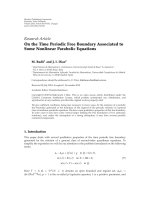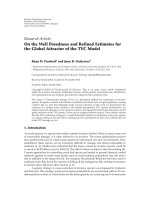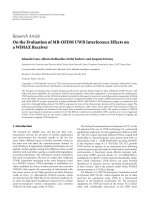Báo cáo hóa học: " Review Article On the Generalized q-Genocchi Numbers and Polynomials of Higher-Order" doc
Bạn đang xem bản rút gọn của tài liệu. Xem và tải ngay bản đầy đủ của tài liệu tại đây (482.41 KB, 8 trang )
Hindawi Publishing Corporation
Advances in Difference Equations
Volume 2011, Article ID 424809, 8 pages
doi:10.1155/2011/424809
Review Article
On the Generalized q-Genocchi Numbers and
Polynomials of Higher-Order
C. S. Ryoo,
1
T. Kim,
2
J. Choi,
2
and B. Lee
3
1
Department of Mathematics, Hannam University, Daejeon 306-791, Republic of Korea
2
Division of General Education-Mathematics, Kwangwoon University,
Seoul 139-701, Republic of Korea
3
Department of Wireless Communications Engineering, Kwangwoon University,
Seoul 139-701, Republic of Korea
Correspondence should be addressed to T. Kim,
Received 10 August 2010; Accepted 18 February 2011
Academic Editor: Roderick Melnik
Copyright q 2011 C. S. Ryoo et al. This is an open access article distributed under the Creative
Commons Attribution License, which permits unrestricted use, distribution, and reproduction in
any medium, provided the original work is properly cited.
We first consider the q-extension of the generating function for the higher-order generalized
Genocchi numbers and polynomials attached to χ. The purpose of this paper is to present a
systemic study of some families of higher-order generalized q-Genocchi numbers and polynomials
attached to χ by using the generating function of those numbers and polynomials.
1. Introduction
As a well known definition, the Genocchi polynomials are defined by
2t
e
t
1
e
xt
e
Gxt
∞
n0
G
n
x
t
n
n!
,
|
t
|
<π,
1.1
where we use the technical method’s notation by replacing G
n
x by G
n
x, symbolically,
see 1, 2. In the special case x 0, G
n
G
n
0 are called the nth Genocchi numbers. From
the definition of Genocchi numbers, we note that G
1
1,G
3
G
5
G
7
··· 0, and even
coefficients are given by G
2n
21 − 2
2n
B
2n
2nE
2n−1
0see 3, where B
n
is a Bernoulli
number and E
n
x is an Euler polynomial. The first few Genocchi numbers for 2, 4, 6, are
−1, 1, −3, 17, −155, 2073, The first few prime Genocchi numbers are given by G
6
−3and
G
8
17. It is known that t here are no other prime Genocchi numbers with n<10
5
. For a real
or complex parameter α, the higher-order Genocchi polynomials are defined by
2t
e
t
1
α
e
xt
∞
n0
G
α
n
x
t
n
n!
1.2
2 Advances in Difference Equations
see 1, 4. In the special case x 0, G
α
n
G
α
n
0 are called the nth Genocchi numbers
of order α.From1.1 and 1.2,wenotethatG
n
G
1
n
. For d ∈ N with d ≡ 1mod 2,
let χ be the Dirichlet character with conductor d. It is known that the generalized Genocchi
polynomials attached to χ are defined by
2t
d−1
a0
χ
a
−1
a
e
at
e
dt
1
e
xt
∞
n0
G
n,χ
x
t
n
n!
1.3
see 1. In the special case x 0, G
n,χ
G
n,χ
0 are called the nth generalized Genocchi
numbers attached to χ see 1, 4–6.
For a real or complex parameter α, the generalized higher-order Genocchi polynomials
attached to χ are also defined by
2t
d−1
a0
χa−1
a
e
at
e
dt
1
α
e
xt
∞
n0
G
α
n,χ
x
t
n
n!
1.4
see 7. In the special case x 0, G
α
n,χ
G
α
n,χ
0 are called the nth generalized Genocchi
numbers attached to χ of order α see 1, 4–9.From1.3 and 1.4, we derive G
n,χ
G
1
n,χ
.
Let us assume that q ∈ C with |q| < 1 as an indeterminate. Then we, use the notation
x
q
1 − q
x
1 − q
.
1.5
The q-factorial is defined by
n
q
!
n
q
n − 1
q
···
2
q
1
q
,
1.6
and the Gaussian binomial coefficient is also defined by
n
k
q
n
q
!
n − k
q
!
k
q
!
n
q
n − 1
q
···
n − k 1
q
k
q
!
1.7
see 5, 10.Notethat
lim
q → 1
n
k
q
n
k
n
n − 1
···
n − k 1
k!
.
1.8
It is known that
n 1
k
q
n
k − 1
q
q
k
n
k
q
q
n1−k
n
k − 1
q
n
k
q
,
1.9
Advances in Difference Equations 3
see 5, 10.Theq-binomial formula are known that
x − y
n
q
x − y
x − qy
···
x − q
n−1
y
n
i0
n
i
q
q
i
2
−1
i
x
n−i
y
i
,
1
x − y
n
q
1
x − y
x − qy
···
x − q
n−1
y
∞
l0
n l − 1
l
q
x
n−l
y
l
,
1.10
see10, 11.
There is an unexpected connection with q-analysis and quantum groups, and thus
with noncommutative geometry q-analysis is a sort of q-deformation of the ordinary analysis.
Spherical functions on quantum groups are q-special functions. Recently, many authors have
studied the q-extension in various areas see 1–15. Govil and Gupta 10 have introduced
a new type of q-integrated Meyer-K
¨
onig-Zeller-Durrmeyer operators, and their results are
closely related to the study of q-Bernstein polynomials and q-Genocchi polynomials, which
are treated in this paper. In this paper, we first consider the q-extension of the generating
function for the higher-order generalized Genocchi numbers and polynomials attached to χ.
The purpose of this paper is to present a systemic study of some families of higher-order
generalized q-Genocchi numbers and polynomials attached to χ by using the generating
function of those numbers and polynomials.
2. Generalized q-Genocchi Numbers and Polynomials
For r ∈ N, let us consider the q-extension of the generalized Genocchi polynomials of order r
attached to χ as follows:
F
r
q,χ
t, x
2
r
t
r
∞
m
1
, ,m
r
0
⎛
⎝
r
j1
χ
m
j
⎞
⎠
−1
r
j1
m
j
e
xm
1
···m
r
q
t
∞
n0
G
r
n,χ,q
x
t
n
n!
. 2.1
Note that
lim
q → 1
F
r
q,χ
t, x
2t
d−1
a0
χa
−1
a
e
at
e
dt
1
r
e
xt
.
2.2
By 2.1 and 1.4, we can see that lim
q → 1
G
r
n,χ,q
xG
r
n,χ
x.From2.1,wenotethat
G
r
0,χ,q
x
G
r
1,χ,q
x
··· G
r
r−1,χ,q
x
0,
G
r
nr,χ,q
x
nr
r
r!
2
r
∞
m
1
, ,m
r
0
⎛
⎝
r
j1
χ
m
j
⎞
⎠
−1
r
j1
m
j
x m
1
··· m
r
n
q
.
2.3
4 Advances in Difference Equations
In the special case x 0, G
r
n,χ,q
G
r
n,χ,q
0 are called the nth generalized q-Genocchi numbers
of order r attached to χ. Therefore, we obtain the following theorem.
Theorem 2.1. For r ∈ N, one has
G
r
nr,χ,q
nr
r
r!
2
r
∞
m
1
, ,m
r
0
r
i1
χ
m
i
−1
r
j1
m
j
m
1
··· m
r
n
q
.
2.4
Note that
2
r
∞
m
1
, ,m
r
0
r
i1
χ
m
i
−1
r
j1
m
j
m
1
··· m
r
n
q
2
r
1 − q
n
n
l0
n
l
−1
l
d−1
a
1
, ,a
r
0
⎛
⎝
r
j1
χ
a
j
⎞
⎠
−q
l
r
i1
a
i
1 q
ld
r
.
2.5
Thus we obtain the following corollary.
Corollary 2.2. For r ∈ N, we have
G
r
nr,χ,q
nr
r
r!
2
r
1 − q
n
n
l0
n
l
−1
l
d−1
a
1
, ,a
r
0
⎛
⎝
r
j1
χ
a
j
⎞
⎠
−q
l
r
i1
a
i
1 q
ld
r
2
r
∞
m0
m r − 1
m
−1
m
d−1
a
1
, ,a
r
0
−1
r
i1
a
i
r
i1
χ
a
i
r
i1
a
i
md
n
q
.
2.6
For h ∈ Z and r ∈ N, one also considers the extended higher-order generalized h, q-Genocchi
polynomials as follows:
F
h,r
q,χ
t, x
2
r
t
r
∞
m
1
, ,m
r
0
q
r
j1
h−jm
j
r
i1
χ
m
i
−1
r
j1
m
j
e
x
r
j1
m
j
q
t
∞
n0
G
h,r
n,χ,q
x
t
n
n!
.
2.7
Advances in Difference Equations 5
From 2.7, one notes that
G
h,r
0,χ,q
x
G
h,r
1,χ,q
x
··· G
h,r
r−1,χ,q
x
0,
G
h,r
nr,χ,q
x
nr
r
r!
2
r
∞
m
1
, ,m
r
0
q
r
j1
h−jm
j
r
i1
χ
m
i
−1
r
j1
m
j
x m
1
··· m
r
n
q
2
r
1 − q
n
n
l0
n
l
q
lx
−1
l
d−1
a
1
, ,a
r
0
⎛
⎝
r
j1
χ
a
j
⎞
⎠
q
r
j1
h−ja
j
−1
a
1
···a
r
q
la
1
···a
r
×
∞
m
1
, ,m
r
0
−1
m
1
···m
r
q
dm
1
···m
r
d
r
j1
h−jm
j
2
r
1 − q
n
n
l0
n
l
q
lx
−1
l
d−1
a
1
, ,a
r
0
r
j1
χ
a
j
q
r
j1
h−ja
j
−q
l
r
j1
a
i
−q
dh−rl
; q
r
,
2.8
where −x; q
r
1 x1 xq ···1 xq
r−1
.
Therefore, we obtain the following theorem.
Theorem 2.3. For h ∈ Z,r ∈ N, one has
G
h,r
nr,χ,q
x
nr
r
r!
2
r
∞
m
1
, ,m
r
0
q
r
j1
h−jm
j
r
i1
χ
m
i
−1
r
j1
m
j
x m
1
··· m
r
n
q
2
r
1 − q
n
n
l0
n
l
−q
x
l
d−1
a
1
, ,a
r
0
r
j1
χ
a
j
q
r
j1
h−ja
j
−q
l
r
j1
a
i
−q
dh−rl
; q
r
,
G
h,r
0,χ,q
x
G
h,r
1,χ,q
x
··· G
h,r
r−1,χ,q
x
0.
2.9
Note that
1
−q
dh−rl
; q
r
1
1 q
dh−rl
∞
m0
m r − 1
m
q
−1
m
q
dh−rlm
.
2.10
By 2.10, one sees that
1
1 − q
n
n
l0
n
l
−1
l
q
lx
r
i1
a
i
−q
dh−rl
; q
r
∞
m0
m r − 1
m
q
−1
m
q
dh−rm
1
1 − q
n
n
l0
n
l
−1
l
q
lx
r
i1
a
i
dm
∞
m0
m r − 1
m
q
−1
m
q
dh−rm
x
r
i1
a
i
dm
n
q
.
2.11
6 Advances in Difference Equations
By 2.10 and 2.11, we obtain t he following corollary.
Corollary 2.4. For h ∈ Z,r ∈ N, we have
G
h,r
nr,χ,q
x
nr
r
r!
2
r
∞
m0
m r − 1
m
q
−1
m
q
dh−rm
d−1
a
1
, ,a
r
0
⎛
⎝
r
j1
χ
a
j
⎞
⎠
q
r
j1
h−ja
j
x
r
i1
a
i
dm
n
q
2.12
By 2.7, we can derive the following corollary.
Corollary 2.5. For h ∈ Z,r,d ∈ N with d ≡ 1 mod 2, we have
q
dh−1
G
h,r
nr,χ,q
x d
nr
r
r!
G
h,r
nr,χ,q
x
nr
r
r!
2
d−1
l0
χ
l
−1
l
G
h−1,r−1
nr−1,χ,q
nr−1
r−1
r − 1
!
,
q
x
G
h1,r
nr,χ,q
x
nr
r
r!
q − 1
G
h,r
nr1,χ,q
x
nr1
r
r!
G
h,r
nr,χ,q
x
nr
r
r!
.
2.13
For h r in Theorem 2.3, we obtain the following corollary.
Corollary 2.6. For r ∈ N, one has
G
r,r
nr,χ,q
x
2
r
1 − q
n
n
l0
n
l
−q
x
l
d−1
a
1
, ,a
r
0
⎛
⎝
r
j1
χ
a
j
⎞
⎠
q
r
j1
r−ja
j
la
j
−1
a
1
···a
r
−q
dl
; q
r
2
r
∞
m0
m r − 1
m
q
−1
m
d−1
a
1
, ,a
r
0
⎛
⎝
r
j1
χ
a
j
⎞
⎠
q
r
j1
r−ja
j
x
r
i1
a
i
dm
n
q
.
2.14
In particular,
G
r,r
nr,χ,q
−1
r − x
nr
r
r!
−1
n
q
n
r
2
G
r,r
nr,χ,q
x
nr
r
r!
.
2.15
Let x r in Corollary 2.6. Then one has
G
r,r
nr,χ,q
−1
nr
r
r!
−1
n
q
n
r
2
G
r,r
nr,χ,q
r
nr
r
r!
.
2.16
Advances in Difference Equations 7
Let w
1
,w
2
, ,w
r
∈ Q
. Then, one has defines Barnes’ type generalized q-Genocchi
polynomials attached to χ as follows:
F
r
q,χ
t, x | w
1
,w
2
, ,w
r
2
r
t
r
∞
m
1
, ,m
r
0
r
i1
χ
m
i
−1
m
1
···m
r
e
x
r
j1
w
j
m
j
q
t
∞
n0
G
r
n,χ,q
x | w
1
,w
2
, ,w
r
t
n
n!
.
2.17
By 2.17, one sees that
G
r
nr,χ,q
x | w
1
, ,w
r
nr
r
r!
2
r
∞
m
1
, ,m
r
0
r
i1
χ
m
i
−1
r
j1
m
j
⎡
⎣
x
r
j1
w
j
m
j
⎤
⎦
n
q
.
2.18
It is easy to see that
2
r
∞
m
1
, ,m
r
0
r
i1
χ
m
i
−1
m
1
···m
r
⎡
⎣
x
r
j1
w
j
m
j
⎤
⎦
n
q
2
r
1 − q
n
n
l0
n
l
−q
x
l
d−1
a
1
, ,a
r
0
r
j1
χ
a
j
−1
r
j1
a
j
q
l
r
j1
w
i
a
i
1 q
dlw
1
···
1 q
dlw
r
.
2.19
Therefore, we obtain the following theorem.
Theorem 2.7. For r ∈ N,w
1
,w
2
, ,w
r
∈ Q
, one has
G
r
nr,χ,q
x | xw
1
,w
2
, ,w
r
nr
r
r!
2
r
∞
m
1
, ,m
r
0
r
i1
χ
m
i
−1
r
j1
m
j
x w
1
m
1
··· w
r
m
r
n
q
2
r
1 − q
n
n
l0
n
l
−q
x
l
d−1
a
1
, ,a
r
0
r
j1
χ
a
j
−1
r
j1
a
j
q
l
r
i1
w
i
a
i
1 q
dlw
1
···
1 q
dlw
r
.
2.20
References
1 L C. Jang, K W. Hwang, and Y H. Kim, “A note on h, q-Genocchi polynomials and numbers of
higher order,” Advances in Difference Equations, vol. 2010, Article ID 309480, 6 pages, 2010.
2 V. Kurt, “A further symmetric relation on the analogue of the Apostol-Bernoulli and the analogue of
the Apostol-Genocchi polynomials,” Applied Mathematical Sciences, vol. 3, no. 53–56, pp. 2757–2764,
2009.
3 T. Kim, “On the q-extension of Euler and Genocchi numbers,” Journal of Mathematical Analysis and
Applications, vol. 326, no. 2, pp. 1458–1465, 2007.
4 L C. Jang, “A study on the distribution of twisted q-Genocchi polynomials,” Advanced Studies in
Contemporary Mathematics (Kyungshang), vol. 18, no. 2, pp. 181–189, 2009.
8 Advances in Difference Equations
5 T. Kim, “Some identities for the Bernoulli, the Euler and the Genocchi numbers and polynomials,”
Advanced Studies in Contemporary Mathematics (Kyungshang), vol. 20, no. 1, pp. 23–28, 2010.
6 T. Kim, “A note on the q-Genocchi numbers and polynomials,” Journal of Inequalities and Applications,
vol. 2007, Article ID 71452, 8 pages, 2007.
7 S H. Rim, S. J. Lee, E. J. Moon, and J. H. Jin, “On the q-Genocchi numbers and polynomials associated
with q-zeta function,” Proceedings of the Jangjeon Mathematical Society, vol. 12, no. 3, pp. 261–267, 2009.
8 S H. Rim, K. H. Park, and E. J. Moon, “On Genocchi numbers and polynomials,” Abstract and Applied
Analysis, vol. 2008, Article ID 898471, 7 pages, 2008.
9 C. S. Ryoo, “Calculating zeros of the twisted Genocchi polynomials,” Advanced Studies in Contemporary
Mathematics (Kyungshang), vol. 17, no. 2, pp. 147–159, 2008.
10 N. K. Govil and V. Gupta, “Convergence of q-Meyer-K
¨
onig-Zeller-Durrmeyer operators,” Advanced
Studies in Contemporary Mathematics (Kyungshang), vol. 19, no. 1, pp. 97–108, 2009.
11 T. Kim, “Barnes-type multiple q-zeta functions and q-Euler polynomials,” Journal of Physics, vol. 43,
no. 25, Article ID 255201, 11 pages, 2010.
12 I. N. Cangul, V. Kurt, H. Ozden, and Y. Simsek, “On the higher-order ω-q-Genocchi numbers,”
Advanced Studies in Contemporary Mathematics (Kyungshang), vol. 19, no. 1, pp. 39–57, 2009.
13 T. Kim, “On the multiple q-Genocchi and Euler numbers,” Russian Journal of Mathematical Physics, vol.
15, no. 4, pp. 481–486, 2008.
14 T. Kim, “Note on the Euler q-zeta functions,” Journal of Number Theory, vol. 129, no. 7, pp. 1798–1804,
2009.
15 M. Cenkci, M. Can, and V. Kurt, “q-extensions of Genocchi numbers,” Journal of the Korean
Mathematical Society, vol. 43, no. 1, pp. 183–198, 2006.









